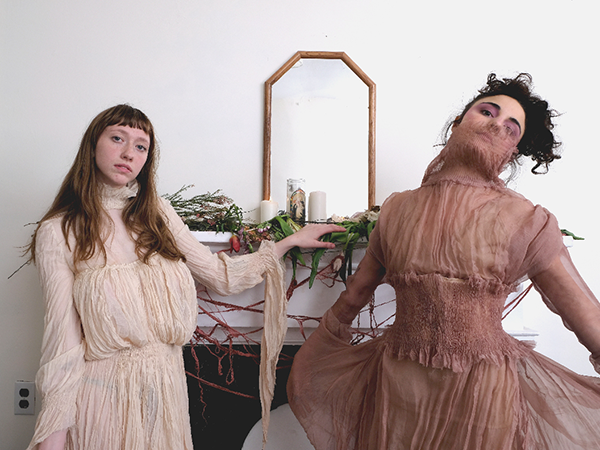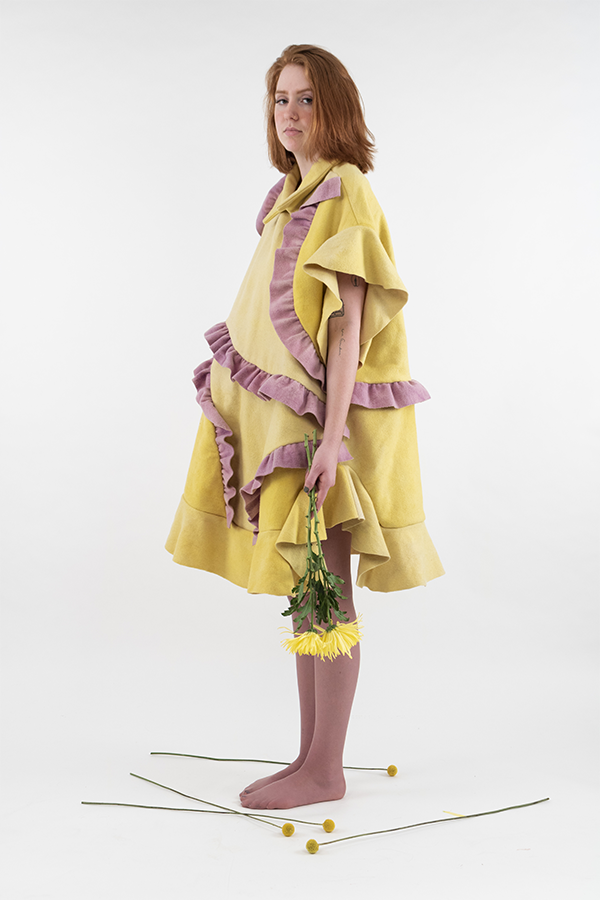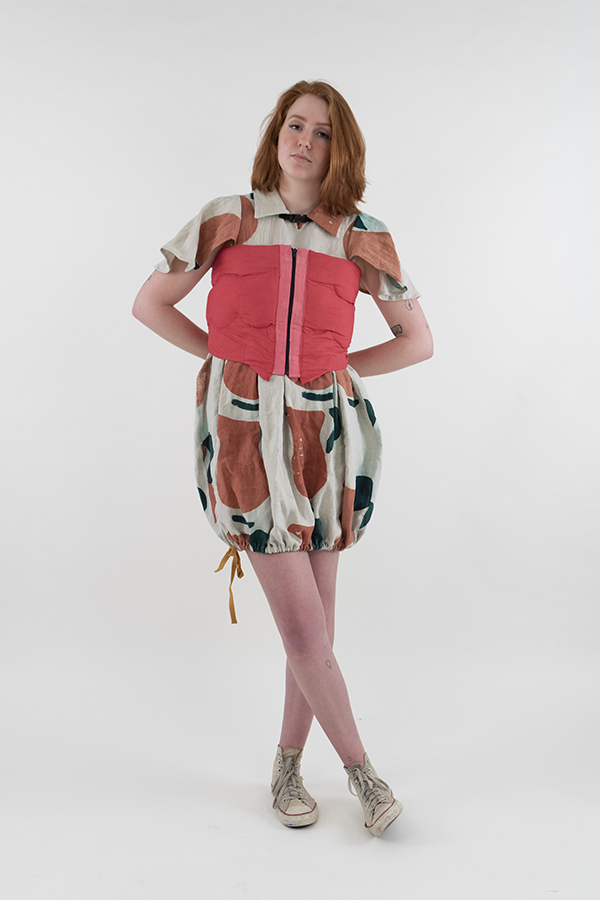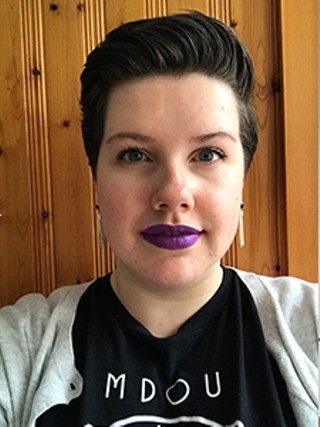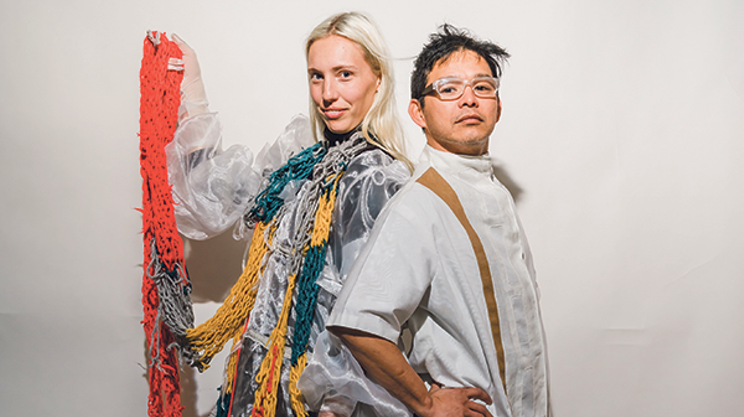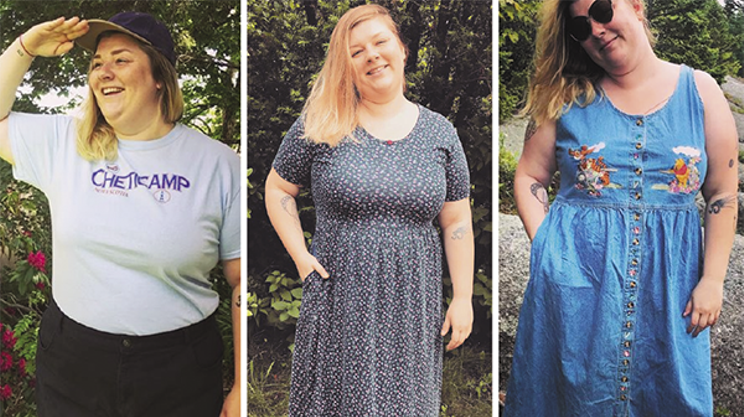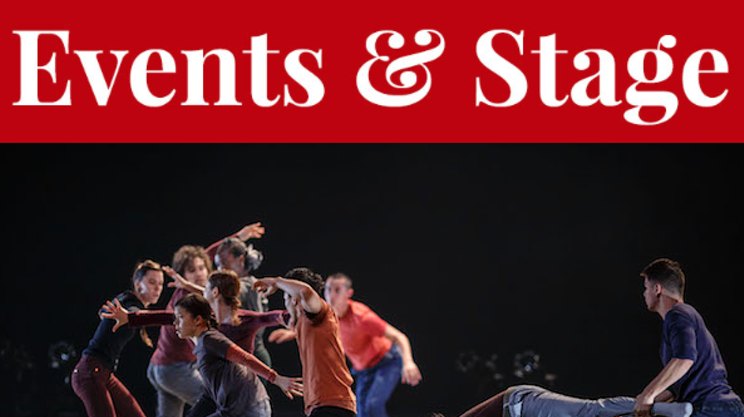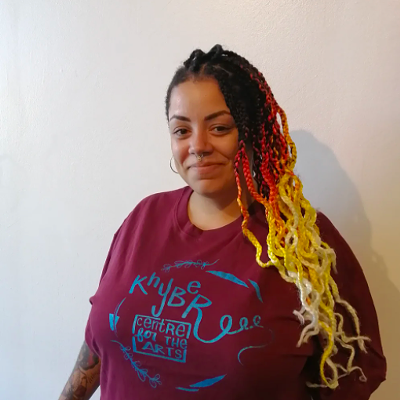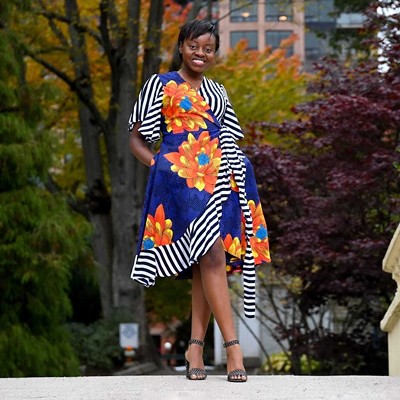1. Angela Fournier
"I love making beautiful things but I also like them to be a little bit absurd. I want people to think, 'That's a little weird.'"Multidisciplinary artist and self-described maximalist Angela Fournier has a few minutes to spare on a break from putting in serious studio time to perfect her latest collection, Histaria. The third-year NSCAD student, whose practice is based in fashion and textiles as well as performance art, explores the feminine identity and the damaging ways we've been conditioned to view it with her soon-to-debut designs. At first glance, her pieces are airy and delicate—soft colours, barely-there fabrics, ambience—but there's tension waiting to be discovered.
"It is about trying to break down structures of idealized feminine beauty and the feminine body. Standards that have been placed on us by fashion and media—systemically based structures—and they've been perpetuated through history. I wanted to use imagery and iconography that was incorporating and critiquing that aspect," says the artist. "Fashion is a really hard place to do that at times—a huge part of the industry is really problematic. It's visually beautiful but I personally feel like it's really limited."
Fournier looked to history for much of her inspiration, religious iconography and corsetry helped her represent the restricting frameworks and power struggles at play in her work.
"They're one of the most controversial garments in history, they deal with dictating the female shape and feminine shape," she says. "I use the corset as a visual tool to break different boundaries of what that garment means systemically."
Because of her background in performance, Fournier promises much movement and gesture when Histaria hits the runway this Saturday. She not only sought out models willing to lean in to their theatrical sides (this is more than just a catwalk in heels) but also folks who represented different bodies and forms of femininity.
"I was trying to think about diversity and different pieces of the feminine identity—it's not just tied to being a woman, that's not what being feminine is," she says. "It's something you tell yourself, and the rest of the world has to accept it. It's about individuality." —AS
2. Jessie McLaughlin
Jessie McLaughlin loves coming-of-age movies—like, really loves them. She and her closest pals gather annually to re-watch A Cinderella Story, where Hilary Duff and Chad Michael Murray deliver an early-internet-era redux of the classic fairy tale. She's seen Juno and Lady Bird nearly as many times, and holds her breath during the prom scene of Never Been Kissed.It's small wonder, then, that the NSCAD student has crafted a line of clothes made of cotton and spun sugar, midday yellows and sunset oranges with dusty pink frills that have the wearer's head and heart emerging out of a soft-sculpture cocoon. "I was really inspired by the narrative or feeling that comes from coming-of-age films and the dance scenes that are shown in those movies," she says. "How it's always this crazy night and it's life-changing, but it actually just turns out to be, in reality—you'd be too awkward to dance and people would be crying in the bathroom.
"Especially in the beginning, I learned a lot about what materials were the appropriate ones to use if you want that silhouette of volume. Wool was the thing that gave me the volume so that things could stick out straight, like the yellow dress: How it hangs off the body like a triangle," McLaughlin offers of the swallow-you-up shapes her collection features, mentioning she rifled through 1970s Sears catalogues for additional inspiration (see the cascading ruffles that slice through that same yellow dress).
"I think with the teen movies, I wanted to show the fun-ness of them. But also, playing in the proportions and the oversized feel plays into that innocence of a child a little bit," she says, noting that her own wardrobe features nothing too tight or aware of the body.
Before slipping into a vintage, oversized wool coat—the sort of thing Molly Ringwald would wear had Sixteen Candles been set in early spring—she offers: "Because fashion is so new to me, I didn't know where I wanted to start. I think that was my favourite silhouette, these over-the-top looks that are so fun." —MM
3. Sienna Maeba
Maeba's collection at NSCAD's Tooth and Nail show is also her first. She says that, along with structurally minded clothing designer Cecile B Hansen, ceramics influenced the making of shorts with a cuff so dramatic it looks like a shelf protruding from the wearer's thigh, and the neo-corset zipped atop bulbous dresses.
"I think 'home' is a really keyword to my aesthetic and my collection, and I always just think what elements and what feelings and what colours make a home. And what makes a space feel comfortable," says Maeba. "I always feel like seeing vases with flowers are beautiful, but even when they're empty, that's really interesting. The idea of vessels as shapes influenced me in my work and that's where, I think, the stuffed element, the big bottoms, the more dimension to things [came from]: Rims of vases and bowls and stuff—that's where I connected the two."
The whole thing feels borne from the same place as Comme des Garçons' iconic 1997 Body Meets Dress, Dress Meets Body show, which saw Rei Kawakubo adding shoulder pads and filler to all latitude and longitude points on gingham gowns (and the female form). Maeba smiles at this comparison. The sense of what the shape is meant to be was never buried: She notes one of her jug-shaped dresses has water pitchers printed all over it.
Print picks up where shape leaves off in Maeba's sartorial story-telling, with hand-sketched plant fronds protruding from hoodie pockets. "I didn't want all the patterns to be perfect, so when I was doing out my stencils for them, it wasn't cut out perfectly smooth—they have parts that I left a little torn and tattered to look used," she says. "I didn't want the audience or viewer to feel like they were looking at something untouchable or intangible. I wanted them to be able to touch it or envision themselves wearing it."
Maeba's collection at NSCAD's Tooth and Nail show is also her first. She says that, along with structurally minded clothing designer Cecile B Hansen, ceramics influenced the making of shorts with a cuff so dramatic it looks like a shelf protruding from the wearer's thigh, and the neo-corset zipped atop bulbous dresses.
"I think 'home' is a really keyword to my aesthetic and my collection, and I always just think what elements and what feelings and what colours make a home. And what makes a space feel comfortable," says Maeba. "I always feel like seeing vases with flowers are beautiful, but even when they're empty, that's really interesting. The idea of vessels as shapes influenced me in my work and that's where, I think, the stuffed element, the big bottoms, the more dimension to things [came from]: Rims of vases and bowls and stuff—that's where I connected the two."
The whole thing feels borne from the same place as Comme des Garçons' iconic 1997 Body Meets Dress, Dress Meets Body show, which saw Rei Kawakubo adding shoulder pads and filler to all latitude and longitude points on gingham gowns (and the female form). Maeba smiles at this comparison. The sense of what the shape is meant to be was never buried: She notes one of her jug-shaped dresses has water pitchers printed all over it.
Print picks up where shape leaves off in Maeba's sartorial story-telling, with hand-sketched plant fronds protruding from hoodie pockets. "I didn't want all the patterns to be perfect, so when I was doing out my stencils for them, it wasn't cut out perfectly smooth—they have parts that I left a little torn and tattered to look used," she says. "I didn't want the audience or viewer to feel like they were looking at something untouchable or intangible. I wanted them to be able to touch it or envision themselves wearing it." —MM

